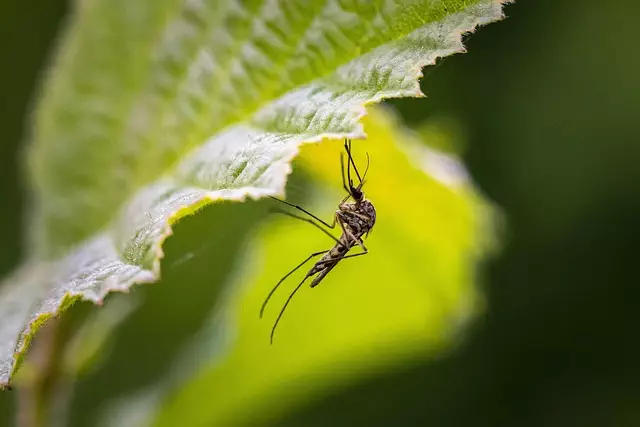Mosquitoes pose a significant global health concern as disease vectors, breeding in standing water and being most active at dawn and dusk. Mosquito control can be achieved through eliminating standing water, using natural repellents, planting citronella and other deterrents, ensuring proper drainage, installing mosquito traps, and wearing protective clothing. Chemical repellents should be used sparingly with proven ingredients like DEET or picaridin. Professional services are vital for managing high-risk areas, while community initiatives focus on long-term solutions like improving drainage and education.
In the quest for mosquito prevention, understanding these pesky vectors of disease is paramount. Mosquito control involves a multi-faceted approach from behavior and breeding pattern recognition to environmental adjustments and protective gear. This comprehensive guide explores effective strategies, including natural and chemical repellents, mosquito nets, professional services, and community initiatives, providing an all-encompassing toolkit for robust mosquito control.
Understanding Mosquitoes: Behavior and Breeding Patterns

Mosquitoes are more than just a nuisance; they are vectors for numerous diseases, making mosquito control a significant global health concern. Understanding their behavior and breeding patterns is crucial in implementing effective prevention strategies. These insects breed in standing water, with female mosquitoes laying their eggs in puddles, buckets, or even small pools left by rainfall. This means that eliminating potential breeding grounds around your home can significantly reduce mosquito populations.
Moreover, mosquitoes are most active during dawn and dusk, when they hunt for blood meals to fuel their reproduction. Knowing these times allows for better protection measures, such as wearing long-sleeved clothing and using insect repellents, especially during peak hours. Understanding their habits equips individuals with the knowledge to employ various mosquito control methods, ensuring a safer and healthier environment.
Creating an Unwelcoming Environment for Mosquitoes

Creating an Unwelcoming Environment for Mosquitoes is a key aspect of effective mosquito control. This involves eliminating standing water, as mosquitoes breed in stagnant water sources like buckets, old tires, and flower pots. Regularly emptying and cleaning these items around your home can significantly reduce mosquito breeding grounds. Additionally, maintaining well-trimmed grass and shrubs helps prevent mosquitoes from resting in shady areas.
Using natural repellents and planting mosquito-repelling plants like citronella, lavender, and marigolds can also deter mosquitoes from entering your outdoor spaces. Ensuring proper drainage and installing mosquito traps or nets further strengthens your mosquito control measures. These simple yet effective strategies transform your environment into a less hospitable one for mosquitoes, thereby enhancing protection against these pesky insects.
Natural Repellents and Their Effectiveness

Mosquitoes can be a nuisance, but there are several natural repellents that prove effective in mosquito control. Essential oils like citronella, lavender, and peppermint are well-known for their ability to ward off these pests. These aromatic compounds contain chemicals that mosquitoes find unpleasant, creating a protective barrier without harmful side effects. For instance, citronella oil, derived from the lemon grass plant, is often used in candles and sprays due to its strong scent that can repel mosquitoes up to 10 feet away.
Beyond essential oils, certain plants play a significant role in mosquito prevention. Mosquitoes are naturally deterred by the strong scents of marigolds, basil, and lemongrass. Planting these around your home or using them in garden sprays can help create an olfactory barrier against these insects. Additionally, natural repellents like neem oil, derived from the neem tree, have been used for centuries to control mosquitoes due to their insecticidal properties. Incorporating these organic solutions into your mosquito protection strategy offers a safer and eco-friendly alternative to synthetic chemicals.
Chemical Repellents and Pesticides: What to Consider

Chemical repellents and pesticides play a significant role in mosquito control, but it’s crucial to approach them with caution. When considering these options, keep in mind the potential environmental impact and health risks associated with certain chemicals. Opt for products containing DEET, picaridin, or oil of lemon eucalyptus, which are proven effective against mosquitoes without posing significant harm when used as directed.
Always follow manufacturer instructions and labels carefully. Be mindful of where you apply these repellents—avoid contact with eyes and sensitive areas, and wash off after swimming or excessive sweating. Additionally, consider the local ecosystem; in some cases, using pesticides can disrupt the balance of natural predators, leading to unforeseen consequences. Choose targeted treatments for specific problem areas to minimize ecological impact.
Protective Clothing and Gear

Protective clothing is an essential component of mosquito control, especially in regions where these pests are prevalent and carry diseases. Long sleeves, pants, and closed-toe shoes can significantly reduce exposure to mosquitoes. Many brands now offer clothing treated with insect repellents, providing added protection. This simple layer of defense is particularly useful for outdoor activities and in areas with high mosquito activity.
For more comprehensive protection, consider gear such as netting and head coverings. Mosquitos are most active during dawn and dusk, so wearing protective attire during these times is crucial. In camping or hiking trips, using insect nets over beds or cots can create a physical barrier against mosquitoes, ensuring a peaceful sleep free from bites.
Mosquito Nets: A Simple Yet Effective Solution

Mosquito nets, a simple yet effective solution for mosquito control, have been a cornerstone of protection against these pesky insects for centuries. Their primary function is to create a physical barrier between humans and mosquitoes, blocking entry into homes, beds, or specific outdoor areas. Made from fine mesh materials like cotton or synthetic fibers, these nets are designed to trap mosquitoes while allowing air to circulate freely.
The effectiveness of mosquito nets lies in their ease of use and accessibility. They can be hung over beds, doors, or windows, providing immediate relief from mosquito bites during sleep or rest. For outdoor activities, treated nets offer an extra layer of protection against mosquito-borne diseases by preventing direct contact with infected mosquitoes. This simple solution is especially crucial in regions where mosquito-transmitted illnesses are prevalent, contributing to better public health and quality of life.
Professional Mosquito Control Services

Professional Mosquito Control Services play a pivotal role in managing and eradicating mosquito populations, especially in commercial or high-risk areas. These services employ specialized equipment and expertise to treat large-scale issues effectively. From misting systems to larvicide applications, professionals offer tailored solutions that target adult mosquitoes, their larvae, and breeding sites. This comprehensive approach ensures a significant reduction in mosquito-borne disease risks.
Engaging the services of experts can be particularly beneficial for regions with historically high mosquito activity or those experiencing sudden outbreaks. Their knowledge of local mosquito behavior and resistance allows for the development of robust strategies. These include seasonal treatments, regular monitoring, and precise application methods, all designed to disrupt the mosquito life cycle and create a safer environment for residents and visitors alike.
Community Efforts and Long-term Strategies

Community efforts play a pivotal role in effective mosquito control and long-term protection. By fostering collaboration among residents, local governments, and health organizations, communities can implement sustainable strategies to reduce mosquito populations. This includes initiatives such as removing standing water, where mosquitoes breed, through regular cleanup campaigns and improving drainage systems. Additionally, community education programs can raise awareness about mosquito habits and the importance of personal protective measures, like using insect repellents and wearing appropriate clothing.
Long-term strategies for mosquito prevention require a multi-faceted approach. Integrating biological control methods, such as introducing natural predators or parasitoids, can help manage mosquito populations ecologically. Moreover, implementing environmental modifications, like planting mosquito-repelling plants or structuring urban spaces to reduce water stagnation, offers ongoing protection. These holistic approaches, combined with regular monitoring and adaptive management, ensure a more comprehensive and resilient mosquito control strategy for communities over time.
